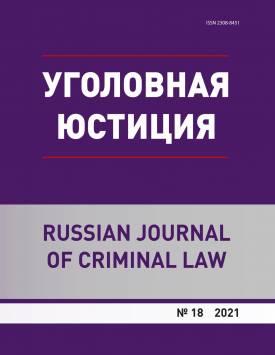Current Issues of the Application of State Protection Measures in the Execution of Precautionary Measures in the Form of Home Confinement, Prohibition of Certain Actions and Bail
Currently, the State Program “Ensuring the Safety of Victims, Witnesses and Other Participants in Criminal Proceedings for 20192023” is in force. Before approving the state program, the initiator provided an analysis of statistical data relating to the previous stage of the program implementation. However, since the data was not analyzed systematically, it suggests a formal approach to organizing annual control and the need to develop necessary changes to the current program. Such programs must take into account the measures of public enforcement, since the preventive measures in the form of home confinement, prohibition of certain actions and bail are directly related to the restriction of the rights and freedoms of a person and citizen. The application of state protection measures leads to the duplication of measures aimed at limiting rights and affects official activities of the bodies responsible for the control and enforcement of preventive measure. The application of state protection measures to suspects and accused with measures of restraint in the form of home confinement, prohibition of certain actions and bail disorganizes the activities of penitentiary institutions related to the implementation of full control over the imposed prohibitions. From 2006 to 2008, measures of state protection were applied to 3,296 persons (5.5% of the projected level). It should be noted that during the period under review, there were no specialized bodies to provide state protection measures. State protection measures were frequently applied to witnesses (63.2%), victims (23%), suspects and accused (3.12%). In 2012, 2,800 participants were covered by state protection measures, which is 17% more than in 2011. From 2014 to 2017, the number of participants in criminal proceedings who were under protection averaged from 3.3 to 3.9 thousand people per year. After analyzing the statistical data on the application of state protection measures, it can be concluded that there are ineffective mechanisms for the implementation of the State Program. In turn, it should be noted that the state has allocated additional significant funds from the federal budget for the application of state protection measures.
Keywords
state protection, preventive measures, security measures, home confinementAuthors
| Name | Organization | |
| Gavrilov Denis I. | Academy of the Federal Penitentiary Service of Russia; Kuzbass Institute of the Federal Penitentiary Service of Russia | ya.den-gavrilov-14@yandex.ru |
References

Current Issues of the Application of State Protection Measures in the Execution of Precautionary Measures in the Form of Home Confinement, Prohibition of Certain Actions and Bail | Ugolovnaya yustitsiya – Russian Journal of Criminal Law. 2021. № 18. DOI: 10.17223/23088451/18/8
